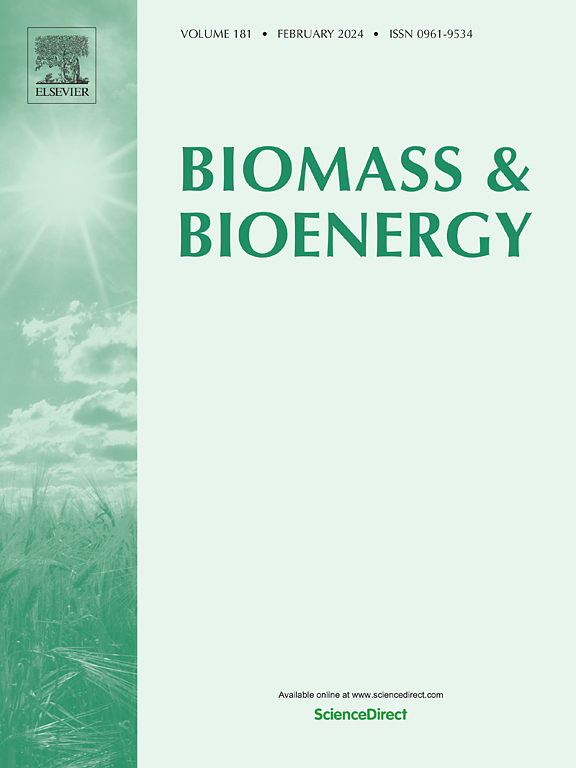通过钙盐辅助模板碳化和 K2CO3 活化耦合从重生物油中提取分层多孔生物炭的纳米结构,用于高性能超级电容器
IF 5.8
2区 生物学
Q1 AGRICULTURAL ENGINEERING
引用次数: 0
摘要
从生物质中提取的生物炭已显示出作为超级电容器电极材料的潜力,但控制其孔隙结构是一项挑战。此外,焦化问题也限制了重质生物油的工业应用,而重质生物油可以用来制备碳质生物炭,作为生物质的替代品。在此,为了拓宽生物油的利用范围并控制其孔隙结构,本研究介绍了一种利用重质生物油并调节孔隙结构的新方法,该方法结合了硬模板法和活化法,其中柠檬酸钙四水合物(CCT)、醋酸钙和碳酸钙作为模板,K2CO3 作为活化剂。通过 700 °C 下的 CCT 辅助模板碳化和质量比为 1:2 的 K2CO3 活化,成功合成了比表面积为 2213.09 m2 g-1 的分层多孔生物炭(CCT-700-1:2)。CCT-700-1:2 电极显示出出色的电容性能,0.5 A 时的比电容为 213.86 F g-1。此外,它还表现出卓越的循环稳定性,即使在循环 60,000 次后,电容保持率仍高达 98%。对称超级电容器还显示出较高的能量密度,在 250 W kg-1 时为 16.36 W h kg-1。这项研究提出了一种利用生物油生产可持续碳材料的方法,可用作储能装置,从而提高了生物质衍生产品在超级电容器领域的潜在利用率。本文章由计算机程序翻译,如有差异,请以英文原文为准。
Nanoarchitectonics of hierarchical porous biochars from heavy bio-oil by coupling calcium salts assisted template carbonization and K2CO3 activation for high-performance supercapacitors
Biochar derived from biomass has shown potential as electrode materials for supercapacitors, but controlling its pore structure is a challenge. Additionally, coking issues have limited the industrial application of heavy bio-oil, which could be used to prepare carbonous biochar as a substitute for biomass. Herein, to widen the utilization of bio-oil and to control the pore structure, this study introduces a novel approach to utilize heavy bio-oil and regulate pore structure by combining the hard template method and activation method, in which calcium citrate tetrahydrate (CCT), calcium acetate and calcium carbonate act as templates and K2CO3 acts as activator. Through CCT-assisted template carbonization at 700 °C and K2CO3 activation with a mass ratio of 1:2, a hierarchical porous biochar (CCT-700–1:2) with a specific surface area of 2213.09 m2 g−1 was successfully synthesized. The CCT-700–1:2 electrode shows outstanding capacitive performance with a specific capacitance of 213.86 F g−1 at 0.5 A. The assembled solid-state symmetric supercapacitor displays impressive rate capability, maintaining the capacity retention ratio being 69.7 % at 20 A g−1. Furthermore, it demonstrates exceptional cycle stability and the capacitance retention is around 98 % even after 60,000 cycles. The symmetric supercapacitors also show the high energy density being 16.36 W h kg−1 at 250 W kg−1. This study presents a hopeful method for producing sustainable carbon materials by bio-oil used as energy storage devices, enhancing the potential utilizations of biomass derived products in the area of supercapacitors.
求助全文
通过发布文献求助,成功后即可免费获取论文全文。
去求助
来源期刊

Biomass & Bioenergy
工程技术-能源与燃料
CiteScore
11.50
自引率
3.30%
发文量
258
审稿时长
60 days
期刊介绍:
Biomass & Bioenergy is an international journal publishing original research papers and short communications, review articles and case studies on biological resources, chemical and biological processes, and biomass products for new renewable sources of energy and materials.
The scope of the journal extends to the environmental, management and economic aspects of biomass and bioenergy.
Key areas covered by the journal:
• Biomass: sources, energy crop production processes, genetic improvements, composition. Please note that research on these biomass subjects must be linked directly to bioenergy generation.
• Biological Residues: residues/rests from agricultural production, forestry and plantations (palm, sugar etc), processing industries, and municipal sources (MSW). Papers on the use of biomass residues through innovative processes/technological novelty and/or consideration of feedstock/system sustainability (or unsustainability) are welcomed. However waste treatment processes and pollution control or mitigation which are only tangentially related to bioenergy are not in the scope of the journal, as they are more suited to publications in the environmental arena. Papers that describe conventional waste streams (ie well described in existing literature) that do not empirically address ''new'' added value from the process are not suitable for submission to the journal.
• Bioenergy Processes: fermentations, thermochemical conversions, liquid and gaseous fuels, and petrochemical substitutes
• Bioenergy Utilization: direct combustion, gasification, electricity production, chemical processes, and by-product remediation
• Biomass and the Environment: carbon cycle, the net energy efficiency of bioenergy systems, assessment of sustainability, and biodiversity issues.
 求助内容:
求助内容: 应助结果提醒方式:
应助结果提醒方式:


